末代皇帝 英文观后感
电影《末代皇帝》观后感
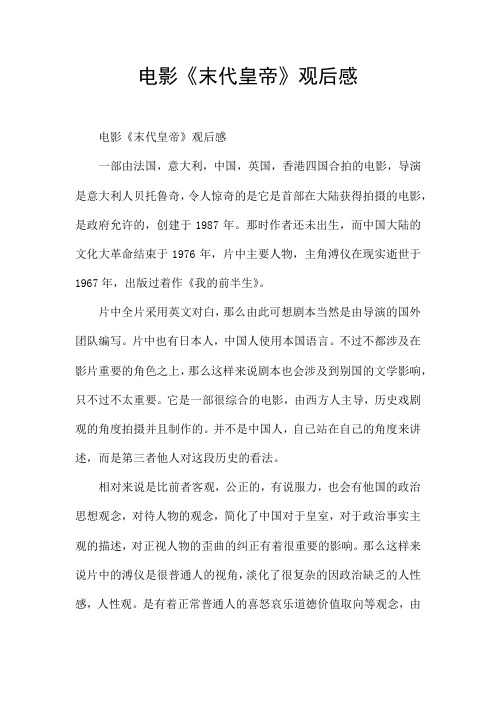
电影《末代皇帝》观后感电影《末代皇帝》观后感一部由法国,意大利,中国,英国,香港四国合拍的电影,导演是意大利人贝托鲁奇,令人惊奇的是它是首部在大陆获得拍摄的电影,是政府允许的,创建于1987年。
那时作者还未出生,而中国大陆的文化大革命结束于1976年,片中主要人物,主角溥仪在现实逝世于1967年,出版过着作《我的前半生》。
片中全片采用英文对白,那么由此可想剧本当然是由导演的国外团队编写。
片中也有日本人,中国人使用本国语言。
不过不都涉及在影片重要的角色之上,那么这样来说剧本也会涉及到别国的文学影响,只不过不太重要。
它是一部很综合的电影,由西方人主导,历史戏剧观的角度拍摄并且制作的。
并不是中国人,自己站在自己的角度来讲述,而是第三者他人对这段历史的看法。
相对来说是比前者客观,公正的,有说服力,也会有他国的政治思想观念,对待人物的观念,简化了中国对于皇室,对于政治事实主观的描述,对正视人物的歪曲的纠正有着很重要的影响。
那么这样来说片中的溥仪是很普通人的视角,淡化了很复杂的因政治缺乏的人性感,人性观。
是有着正常普通人的喜怒哀乐道德价值取向等观念,由一个复杂的历史政治人物,因他国的介入由此简化了实在一个普通人的人物命运,对于事实事物的选择,更能的凸显一个因上时代的变化,因家庭出身等等原因产生的个人的不幸,而对于共同历史来说又是万幸的,由于他的下台,结束了长达208年满清专制的统治,由于他的离开结束了长达5000年中国封建的社会制度,而由此走向了现代化。
令作者影响之深的是导演背景的音乐与镜头的运用十分的打动人,经典的片中台词“Open the door”一共出现了3次以上,实在让人联想起由当时慈禧太后统治的旧时代中国的“闭关锁国”政策,而极具讽刺的是溥仪的家人死于吸食鸦片,而鸦片正视当时英法等国,敲开旧时中国的很重要的敲门砖。
科技思想的落后终于促使我们“Open the door”了。
不在固步自封,自以为是,就像片中经典的段落溥仪趴在古老的故宫地砖上,听到陈旧的厚实的城墙外,喊杀打的声音,仿佛那时的旧中国被厚厚的城墙所隔离,与外部世界断开了联系了,外界发生的任何事物与我们好像没有任何的联系,英法等西方国家已经经过过工业革命,文艺复兴,不断的推翻重来推翻重来,而这边中国还在置办慈禧的六十大寿而大费国力……实在让人啼笑皆非。
末代皇帝观后感英语
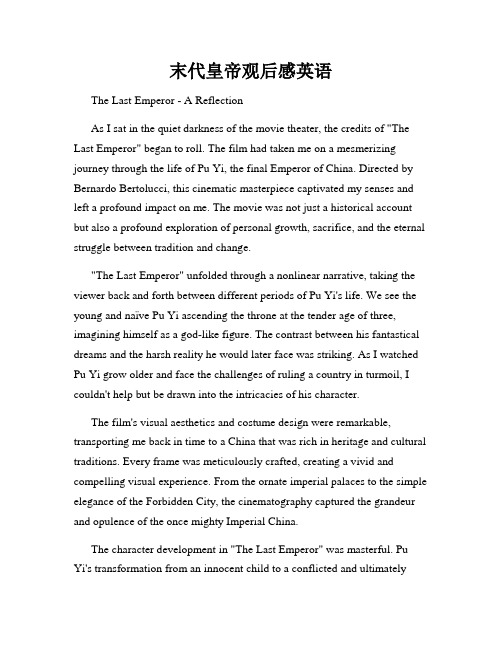
末代皇帝观后感英语The Last Emperor - A ReflectionAs I sat in the quiet darkness of the movie theater, the credits of "The Last Emperor" began to roll. The film had taken me on a mesmerizing journey through the life of Pu Yi, the final Emperor of China. Directed by Bernardo Bertolucci, this cinematic masterpiece captivated my senses and left a profound impact on me. The movie was not just a historical account but also a profound exploration of personal growth, sacrifice, and the eternal struggle between tradition and change."The Last Emperor" unfolded through a nonlinear narrative, taking the viewer back and forth between different periods of Pu Yi's life. We see the young and naïve Pu Yi ascending the throne at the tender age of three, imagining himself as a god-like figure. The contrast between his fantastical dreams and the harsh reality he would later face was striking. As I watched Pu Yi grow older and face the challenges of ruling a country in turmoil, I couldn't help but be drawn into the intricacies of his character.The film's visual aesthetics and costume design were remarkable, transporting me back in time to a China that was rich in heritage and cultural traditions. Every frame was meticulously crafted, creating a vivid and compelling visual experience. From the ornate imperial palaces to the simple elegance of the Forbidden City, the cinematography captured the grandeur and opulence of the once mighty Imperial China.The character development in "The Last Emperor" was masterful. PuYi's transformation from an innocent child to a conflicted and ultimatelybroken man fascinated me. As he is forced to abdicate the throne and adapt to a life outside the palace walls, Pu Yi becomes a mere pawn in the political games of the time. The film skillfully portrays his struggle to find his own identity and purpose in a world that has changed beyond recognition.Throughout the movie, Pu Yi's relationships with other characters served as a reflection of the shifting dynamics in China. From his close bond with his wet nurse, Wang, to his tumultuous friendship with his adoptive brother, Pu Ren, each relationship showcased the complexities of love, loyalty, and betrayal. These relationships reveal the conflicting forces of tradition and modernity that Pu Yi grapples with, mirroring the larger struggle faced by the nation.One of the most poignant scenes in the film occurs when a grown-up Pu Yi returns to the Forbidden City, now an ordinary museum. As he walks through the empty halls that were once filled with power and authority, a deep sense of loss and nostalgia overwhelms him. It becomes evident that the vastness of the Forbidden City mirrors the emptiness Pu Yi feels within himself. The scene symbolizes the demise of a fallen era, of traditions and values swept away by the winds of change."The Last Emperor" also sheds light on the impact of political ideologies on individuals. During Pu Yi's time as a puppet emperor under Japanese occupation, he is persuaded to embrace the ideals of Japanese militarism. It is in these moments that we witness the utmost vulnerability of Pu Yi as he succumbs to external pressures and loses touch with his inner self. This portrayal not only exemplifies the devastating consequences of blindadherence to political ideologies but also serves as a cautionary tale for all societies.As the credits finished rolling, I sat in silence, contemplating the profound story that had just unfolded before my eyes. "The Last Emperor" is not just a historical drama; it is a thought-provoking exploration of personal growth, the clash of tradition and modernity, and the consequences of political ideologies. It is a film that stays with you long after you leave the theater, lingering in your mind and heart.In conclusion, "The Last Emperor" is a visual masterpiece that delves into the complex life of Pu Yi, the last ruler of Imperial China. The film's masterful storytelling, stunning visuals, and exceptional performances create a deep emotional impact on the viewer. Through Pu Yi's journey, we are reminded of the importance of self-discovery, the fragility of tradition, and the power of individual choice in the face of political turmoil. "The Last Emperor" is a testament to the enduring power of cinema to enlighten, inspire, and provoke introspection.。
电影《Queen》观后感(英文)
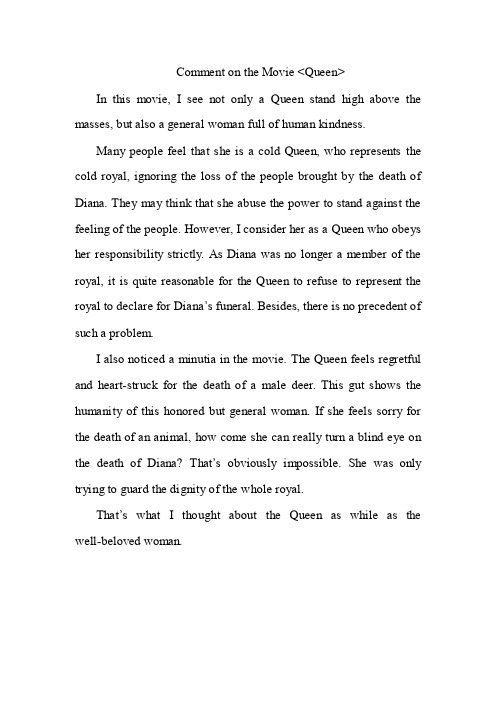
Comment on the Movie <Queen>In this movie, I see not only a Queen stand high above the masses, but also a general woman full of human kindness.Many people feel that she is a cold Queen, who represents the cold royal, ignoring the loss of the people brought by the death of Diana. They may think that she abuse the power to stand against the feeling of the people. However, I consider her as a Queen who obeys her responsibility strictly. As Diana was no longer a member of the royal, it is quite reasonable for the Queen to refuse to represent the royal to declare for Diana’s funeral. Besides, there is no precedent of such a problem.I also noticed a minutia in the movie. The Queen feels regretful and heart-struck for the death of a male deer. This gut shows the humanity of this honored but general woman. If she feels sorry for the death of an animal, how come she can really turn a blind eye on the death of Diana? That’s obviously impossible. She was only trying to guard the dignity of the whole royal.That’s what I thought about the Queen as while as the well-beloved woman.。
末代皇帝观后感英语300
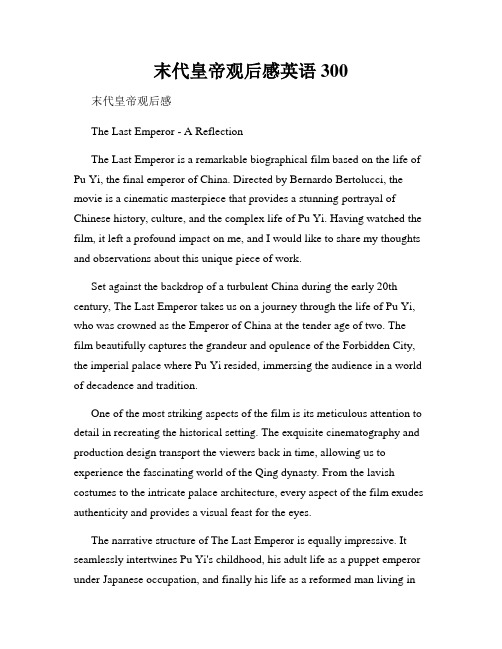
末代皇帝观后感英语300末代皇帝观后感The Last Emperor - A ReflectionThe Last Emperor is a remarkable biographical film based on the life of Pu Yi, the final emperor of China. Directed by Bernardo Bertolucci, the movie is a cinematic masterpiece that provides a stunning portrayal of Chinese history, culture, and the complex life of Pu Yi. Having watched the film, it left a profound impact on me, and I would like to share my thoughts and observations about this unique piece of work.Set against the backdrop of a turbulent China during the early 20th century, The Last Emperor takes us on a journey through the life of Pu Yi, who was crowned as the Emperor of China at the tender age of two. The film beautifully captures the grandeur and opulence of the Forbidden City, the imperial palace where Pu Yi resided, immersing the audience in a world of decadence and tradition.One of the most striking aspects of the film is its meticulous attention to detail in recreating the historical setting. The exquisite cinematography and production design transport the viewers back in time, allowing us to experience the fascinating world of the Qing dynasty. From the lavish costumes to the intricate palace architecture, every aspect of the film exudes authenticity and provides a visual feast for the eyes.The narrative structure of The Last Emperor is equally impressive. It seamlessly intertwines Pu Yi's childhood, his adult life as a puppet emperor under Japanese occupation, and finally his life as a reformed man living incommunist China. This multi-layered approach gives the audience a comprehensive understanding of Pu Yi's transformation from an innocent child to a flawed ruler, and eventually a humble citizen.In addition to its historical and cultural significance, The Last Emperor also explores profound themes such as identity, power, and personal growth. Pu Yi's journey mirrors the complexities and challenges faced by China as a nation during a period of immense change. From being revered as a living god to being stripped of his title and forced to adapt to a new way of life, Pu Yi's tumultuous life serves as a reflection of the struggles and transformations that China experienced during this era.The performances in The Last Emperor are commendable, particularly that of John Lone, who portrays Pu Yi with great depth and vulnerability. Lone captures the essence of Pu Yi's character, showcasing his arrogance, curiosity, and eventual humility with nuance and subtlety. The supporting cast, including Joan Chen as Pu Yi's wife and Peter O'Toole as his Scottish tutor, deliver performances that add richness and authenticity to the storytelling.While The Last Emperor is primarily an exploration of a specific time and place in history, it also raises universal questions about power and its consequences. Pu Yi's rise and fall from power serve as a cautionary tale, reminding us of the importance of humility, empathy, and embracing change. It is a poignant reminder that even the mightiest can be brought down, and that true strength lies in one's ability to adapt and learn from past mistakes.In conclusion, The Last Emperor is a cinematic masterpiece that offers a captivating glimpse into the life of Pu Yi and the historical contextsurrounding him. Through its stunning visuals, compelling narrative, and thought-provoking themes, the film provides a powerful experience that lingers in the mind long after the credits roll. It serves as a testament to the enduring legacy of the last emperor of China and the complex history of a nation in transition.。
英文电影观后感 last holiday
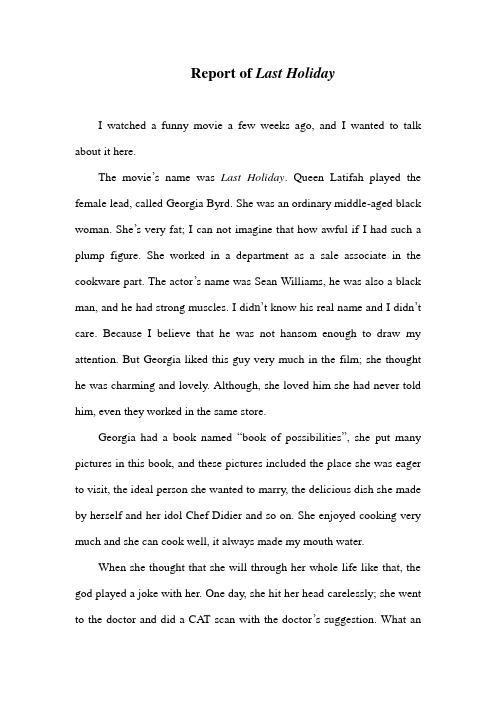
Report of Last HolidayI watched a funny movie a few weeks ago, and I wanted to talk about it here.The movie’s name was Last Holiday. Queen Latifah played the female lead, called Georgia Byrd. She was an ordinary middle-aged black woman. She’s very fat; I can not imagine that how awful if I had such a plump figure. She worked in a department as a sale associate in the cookware part. The actor’s name was Sean Williams, he was also a black man, and he had strong muscles. I did n’t know his real name and I didn’t care. Because I believe that he was not hansom enough to draw my attention. But Georgia liked this guy very much in the film; she thought he was charming and lovely. Although, she loved him she had never told him, even they worked in the same store.Georgia had a book named “book of possibilities”, she put many pictures in this book, and these pictures included the place she was eager to visit, the ideal person she wanted to marry, the delicious dish she made by herself and her idol Chef Didier and so on. She enjoyed cooking very much and she can cook well, it always made my mouth water.When she thought that she will through her whole life like that, the god played a joke with her. One day, she hit her head carelessly; she went to the doctor and did a CAT scan with the doctor’s suggestion. What anincredible thing! The result of this CAT scan was that she had Lampington’s disease which was very rare and terminal. The doctor told her: “in your condition, you’ve got about three weeks to live.” The news came as a thunderbolt. She cried, drank, because she just can’t believe it.When the doctor told her that the cost of a median cranial debunking surgery was around 340,000 dollars, she gave herself up and made a critical decision, she quit her job, liquidated the entire IRA, sold all of the bonds her mother left her, so, she got a large amount of money, but she just wanted to ran out of it.She chose to fly first class to the place she itches to visit---Karlovy Vary. Then she took the helicopter to her hotel. This hotel was the local most famous one, many famous people chose it. What’s more, her idol chef Didier worked in this hotel. She lived in a Presidential suite, took the expensive snowboarding lessons, ordered all the specials which was cooked by Chef Didier. Many famous people in this hotel were surprised by her and interested in her identity. But they also respected her, because Georgia was easygoing, friendly, humorous and never pride. She became the highlight in this hotel. The stuff in this hotel also thought she was the most amazing person who ever came to here; she just lives on the edge. When people knew that she was just a sales associate and only had three weeks to live, all the people were shocked and felt sorry about it. But then, the hotel received a telegram which sent by the hospital, the contentwas:“you have been misdiagnosed due to a faulty CAT-scan machine. You don’t have Lampington’s disease.”So, finally, Georgia got married with Sean the guy she loved, and realize her dream to set up a restaurant with her husband. What a happy ending it had.Maybe the ending was a little secular, but I still loved this movie. I saw a true existentialist, she just said what she wanted and did what she wanted, never mind whether people will laugh at her. I admired her attitude towards the life; even she can only live for three weeks. I didn’t know what will I do if I got this horrible news, but I can sure that I won’t do like Georgia. I have no courage. I was no brave enough. Maybe I just worried about my disease everyday and wait for died. My favorite scene in this film was when Georgia stood by the window of that hotel, she looked out of the window and she was intoxicated by the beauty of the outside, she said “what world was I living in.” She didn’t want die. There were lots of beautiful things in our world. People always found how wonderful the world was when they going to die, but it was too late. After watching that film I learnt many things. Perhaps, I couldn’t find the truth of the life, but I thought I can find the treasures in my life and cherish them. My parents, my friends, my lover and my dream which I hold. I also had the book of possibilities in my heart, and I wish I can turn it into the book of realities by work hard.And I believed that everyone can make their dream come true if they live every single day to the fullest.。
末代皇帝英文观后感

末代皇帝英文观后感《末代皇帝》(The Last Emperor)是一部由贝纳尔多·贝托鲁奇(Bernardo Bertolucci)执导的电影,讲述了中国末代皇帝——溥仪的一生。
这部电影以其独特的叙事方式和卓越的制作而成为一个经典作品。
在观看这部电影后,我深受感动和震撼,对中国历史和人性有了更深刻的理解。
电影从溥仪的童年开始,展现了他作为一个小孩子如何被选为中国最后一位皇帝,并在逼仄的王宫中度过了他的童年和少年时代。
影片通过细腻的细节和令人入迷的镜头表达了这个特殊时期的中国社会和政治氛围。
我被影片中生动的画面所吸引,如宫殿的华丽、礼仪的繁复以及帝国内部的权力斗争。
这些细节展示了中国封建时代独特的文化和制度,使我对这个时代有了更深入的了解。
影片的剧情发展贯穿了整个溥仪的一生,从他成为皇帝到被废黜,再到成为一名普通公民。
通过这一过程,观众得以见证溥仪从被人们追捧和顺从到被人们唾弃和忽视的变化。
我对这种权力的蜕变和人心的变幻深感惋惜。
溥仪是一个被历史洪流所冲击的无辜少年,他并没有选择成为皇帝,却要承担起整个帝国的压力和责任。
他的际遇让我对历史中的个人命运产生了深思。
影片中的演员表演出色,特别是小演员陈百强饰演的年轻溥仪。
他通过精湛的演技和情感表达让我对这个角色产生了共鸣。
他凭借稚嫩的面孔和纯真的眼神刻画出了一个无辜受害者的形象,我为他的表演所打动。
此外,其他演员也都以出色的表演赋予了影片更加真实和感人的氛围。
电影还通过溥仪与外国人的交往,呈现了中国历史上的重大事件和时代变革。
从溥仪的少年时期开始,他与外国人建立了亲密的关系,并被引导进入了现代化的世界。
这一过程不仅改变了他的世界观,也改变了中国的历史进程。
从这个角度来看,溥仪的一生是中国晚清时期和民国时期国家现代化转型的一个缩影。
这一点让我对中国的近代史产生了浓厚的兴趣,也让我思考了自己的身份认同和文化观念。
《末代皇帝》是一部以历史为背景的电影,但它更多地展示了人性的复杂和欲望的冲突。
末代皇帝观后感英文版
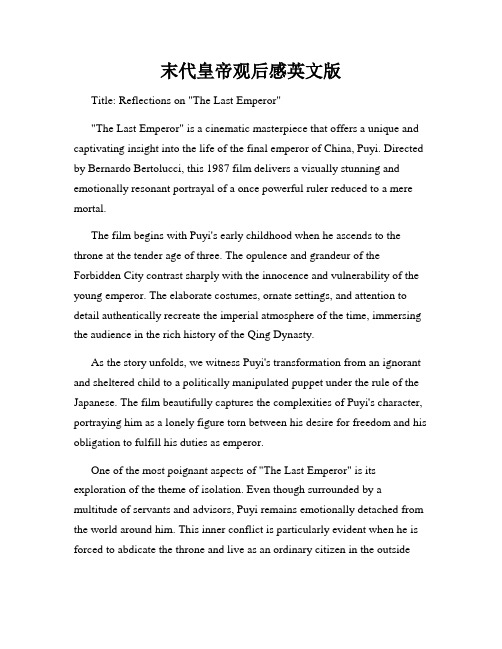
末代皇帝观后感英文版Title: Reflections on "The Last Emperor""The Last Emperor" is a cinematic masterpiece that offers a unique and captivating insight into the life of the final emperor of China, Puyi. Directed by Bernardo Bertolucci, this 1987 film delivers a visually stunning and emotionally resonant portrayal of a once powerful ruler reduced to a mere mortal.The film begins with Puyi's early childhood when he ascends to the throne at the tender age of three. The opulence and grandeur of the Forbidden City contrast sharply with the innocence and vulnerability of the young emperor. The elaborate costumes, ornate settings, and attention to detail authentically recreate the imperial atmosphere of the time, immersing the audience in the rich history of the Qing Dynasty.As the story unfolds, we witness Puyi's transformation from an ignorant and sheltered child to a politically manipulated puppet under the rule of the Japanese. The film beautifully captures the complexities of Puyi's character, portraying him as a lonely figure torn between his desire for freedom and his obligation to fulfill his duties as emperor.One of the most poignant aspects of "The Last Emperor" is its exploration of the theme of isolation. Even though surrounded by a multitude of servants and advisors, Puyi remains emotionally detached from the world around him. This inner conflict is particularly evident when he is forced to abdicate the throne and live as an ordinary citizen in the outsideworld. Puyi's struggles to adapt to a life devoid of privilege and to find a sense of self-identity are profoundly moving.The film's narrative structure is another aspect that contributes to its brilliance. The use of flashbacks and non-linear storytelling provides a layered and nuanced understanding of Puyi's life. By interweaving different periods of his existence, the viewer gains insight into the events that shaped the emperor's beliefs and actions. The juxtaposition of Puyi's childhood innocence with his later regret and remorse creates a multi-dimensional and sympathetic portrayal of his character.Moreover, "The Last Emperor" addresses larger historical and political issues that extend beyond Puyi's personal story. It sheds light on the tumultuous period of China's history, marked by the fall of dynastic rule, the rise of political ideologies, and foreign occupation. Through Puyi's experiences, the audience is exposed to the transformative power of political unrest and the fragility of power.The visual aesthetics of the film deserve special mention. Vittorio Storaro's meticulous cinematography captures the grandeur of the Forbidden City and the harsh realities of Puyi's later life with equal mastery. His use of color and light evokes a sense of time and place, further enhancing the overall atmospheric experience for viewers.In terms of performances, "The Last Emperor" showcases a truly exceptional cast. From John Lone's portrayal of the adult Puyi to Joan Chen's poignant performance as his loyal wife, the actors deliver nuanced and deeply emotional portrayals of their characters. Their collective abilityto communicate complex emotions without relying on extensive dialogue is a testament to their skills and the essence of their performances.In conclusion, "The Last Emperor" is a cinematic masterpiece that transcends the boundaries of time and culture. Its exploration of power, identity, and the human spirit resonates with audiences on a profound level. Through Bertolucci's masterful direction, the film immerses viewers in a world that is both alien and familiar, reminding us of the fragility of power and the universal yearning for freedom and meaning.。
电影末代皇帝英文作文

电影末代皇帝英文作文The Last Emperor is a biographical film directed by Bernardo Bertolucci, which tells the story of Pu Yi, the last Emperor of China. The movie is based on Pu Yi's autobiography and offers a glimpse into the tumultuous period of Chinese history during the early 20th century. In this essay, I will discuss the historical context, the portrayal of Pu Yi's life, and the film's overall impact.The Last Emperor is set against the backdrop of the declining Qing Dynasty and the subsequent political changes in China. It begins with Pu Yi's childhood as the Emperor of China, where he is isolated from the outside world and lives a life of luxury and privilege. However, as the film progresses, we witness the downfall of the Qing Dynasty, the rise of the Republic of China, and the eventual establishment of the People's Republic of China.The film effectively portrays the transformation of Pu Yi from an innocent child to a puppet emperor manipulatedby various political forces. As he grows older, Pu Yi becomes more aware of the changing political landscape and the diminishing power of the emperor. He is eventually forced to abdicate the throne and is imprisoned by the Japanese during their occupation of Manchuria.The Last Emperor also explores Pu Yi's personal struggles and his search for identity. After his release from prison, he is captured by the Soviet Union and held as a prisoner. During his time in captivity, Pu Yi undergoes a process of self-reflection and comes to terms with his role as the last emperor. He realizes the futility of his position and embraces a new life as an ordinary citizen.One of the most significant aspects of the film is its portrayal of Chinese history and culture. The Last Emperor provides a visually stunning representation of the Forbidden City and the imperial court. The costumes, set designs, and cinematography all contribute to creating an authentic and immersive experience for the audience.Furthermore, the film offers a critical commentary onthe impact of political ideologies on individuals. Pu Yi's life is shaped by the conflicting ideologies of monarchism, nationalism, and communism. He is used as a pawn by different political factions, highlighting thevulnerability of individuals in the face of largerpolitical forces.The Last Emperor received critical acclaim upon its release and won numerous awards, including nine Academy Awards. It is widely regarded as a masterpiece of filmmaking and a significant contribution to the biographical genre.In conclusion, The Last Emperor is a captivating film that provides a compelling portrayal of the life of Pu Yi, the last Emperor of China. It effectively captures the historical context, explores the personal struggles of its protagonist, and offers a critical commentary on the impact of political ideologies. Through its stunning visuals and powerful storytelling, the film leaves a lasting impact on its audience and serves as a testament to the complexities of Chinese history.。
帝国的覆灭观后感英语演讲
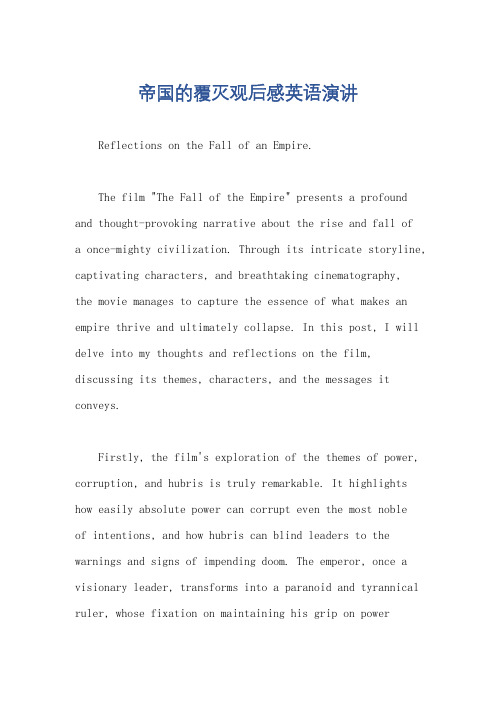
帝国的覆灭观后感英语演讲Reflections on the Fall of an Empire.The film "The Fall of the Empire" presents a profound and thought-provoking narrative about the rise and fall ofa once-mighty civilization. Through its intricate storyline, captivating characters, and breathtaking cinematography,the movie manages to capture the essence of what makes an empire thrive and ultimately collapse. In this post, I will delve into my thoughts and reflections on the film, discussing its themes, characters, and the messages it conveys.Firstly, the film's exploration of the themes of power, corruption, and hubris is truly remarkable. It highlights how easily absolute power can corrupt even the most nobleof intentions, and how hubris can blind leaders to the warnings and signs of impending doom. The emperor, once a visionary leader, transforms into a paranoid and tyrannical ruler, whose fixation on maintaining his grip on powerleads to the gradual decay of his empire. This narrative resonates deeply with historical parallels, reminding us of the importance of checking our own instincts for power and the dangers of ignoring the warnings of those we lead.The film's characters are also wonderfully crafted, each with their own unique traits and motivations. The emperor, while initially charming and charismatic, transforms into a cold and calculating ruler as the film progresses. His advisors and courtiers, each with their own agendas and ambitions, provide a vivid portrayal of the politics and intrigue that often underlie the facade of power. The film's protagonist, a loyal but disillusioned general, serves as a voice of reason and conscience, providing a contrast to the emperor's increasingly erratic behavior. His struggle between loyalty and duty, and his ultimate choice to act against the emperor, is a heartbreaking but necessary arc that drives the film's narrative forward.The cinematography of "The Fall of the Empire" is also breathtaking. The film's use of color, lighting, andcomposition creates a vivid and immersive world that draws the viewer in. The opulent palaces and bustling cities are a testament to the empire's former glory, while the decaying ruins and empty streets reflect its current state of decay. This visual contrast serves to emphasize thefilm's themes of decline and fall, providing a stark reminder of the impermanence of power and wealth.The film's message about the importance of wisdom, humility, and responsibility in leadership is also crucial. It suggests that leaders should be guided by reason and compassion, rather than blind ambition and paranoia. The emperor's failure to listen to his advisors, his refusal to accept criticism, and his obsession with maintaining absolute control ultimately lead to the collapse of his empire. This serves as a warning to leaders everywhere that power should be used responsibly and with humility, andthat ignoring the warnings of those we lead can have disastrous consequences.In conclusion, "The Fall of the Empire" is a thought-provoking and insightful film that explores thecomplexities of power, corruption, and leadership. Its themes and messages are as relevant today as they were when the film was made, serving as a valuable reminder of the importance of wisdom, humility, and responsibility in leadership. The film's characters, cinematography, and narrative all contribute to its overall impact, making it a must-watch for anyone interested in history, politics, or the human quest for power and meaning.。
heidi电影英文观后感

heidi电影英文观后感The film "Heidi" is a heartwarming tale that captures the essence of childhood innocence and the power of nature. Set against the breathtaking backdrop of the Swiss Alps, it tells the story of a young orphan girl who finds solace and joy in the company of her grandfather and the surrounding environment.Heidi's infectious spirit and her unwavering kindness to everyone she meets serve as a gentle reminder of the importance of empathy and compassion. The film beautifully illustrates how the bonds of friendship can transcend social status and age, as seen through her relationships with the gruff grandfather and the lonely Peter.One of the most poignant aspects of the movie is the transformation of Heidi's grandfather. Initially portrayed as a reclusive and bitter man, his heart softens as he becomes a loving guardian to Heidi, showcasing the redemptive power of love and acceptance.The cinematography in "Heidi" is nothing short of spectacular, with sweeping shots of the majestic mountains and lush valleys that not only provide a stunning visual experience but also symbolize the freedom and boundless potential that life offers.The film's narrative is a testament to the resilience ofthe human spirit, as it follows Heidi's journey through various trials and tribulations, always maintaining her cheerful disposition and optimism. It is a story that resonates with viewers of all ages, teaching us the value of simplicity and the strength that comes from being true to oneself.In its portrayal of Heidi's life in the city, the movie contrasts the bustling and structured urban life with the tranquility and freedom of the mountains, highlighting the stark differences in the way people live and the impact it has on their well-being.The soundtrack of "Heidi" complements the film's visual and emotional landscape, with its soothing melodies that evoke a sense of peace and longing for the simplicity of life in the mountains.Ultimately, "Heidi" is a timeless classic that speaks to the universal themes of love, family, and the beauty of nature. It is a film that leaves a lasting impression, inspiring viewers to cherish the simple joys in life and to embrace the transformative power of love and kindness.。
电影2012英文观后感100词
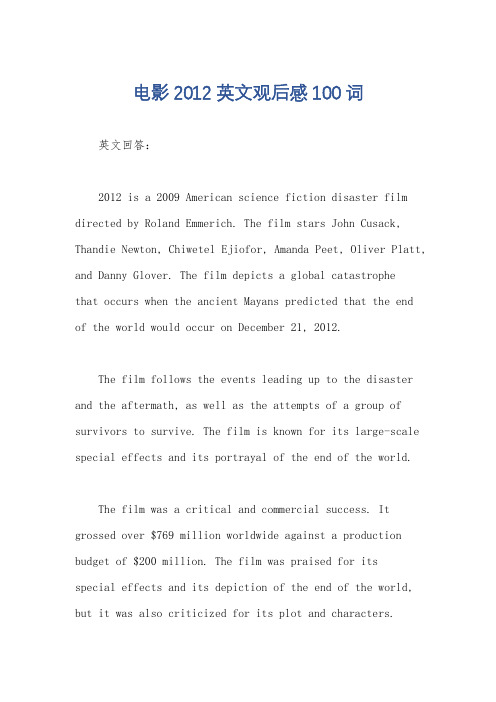
电影2012英文观后感100词英文回答:2012 is a 2009 American science fiction disaster film directed by Roland Emmerich. The film stars John Cusack, Thandie Newton, Chiwetel Ejiofor, Amanda Peet, Oliver Platt, and Danny Glover. The film depicts a global catastrophethat occurs when the ancient Mayans predicted that the endof the world would occur on December 21, 2012.The film follows the events leading up to the disaster and the aftermath, as well as the attempts of a group of survivors to survive. The film is known for its large-scale special effects and its portrayal of the end of the world.The film was a critical and commercial success. It grossed over $769 million worldwide against a production budget of $200 million. The film was praised for itsspecial effects and its depiction of the end of the world, but it was also criticized for its plot and characters.中文回答:2012 是一部由罗兰·艾默里奇执导的 2009 年美国科幻灾难片。
末代皇帝英文作文

末代皇帝英文作文The last emperor of China, Puyi, was a controversial figure in history. He was a puppet emperor under the ruleof the Japanese during World War II, and later became a member of the Communist Party. His life was full of ups and downs, and his legacy is still debated today.Puyi's early life was marked by luxury and privilege as the ruler of the Qing Dynasty. However, his reign wasshort-lived, and he was forced to abdicate the throne at a young age. Despite this, he continued to live a lavish lifestyle, surrounded by servants and concubines, until he was expelled from the Forbidden City.After being ousted from power, Puyi lived a tumultuous life. He was first a puppet emperor under the Japanese occupation, and later a prisoner under the Communist regime. His experiences reflected the political turmoil of China during the 20th century, and he was used as a pawn by various powers vying for control.Despite his controversial past, Puyi eventually found redemption in his later years. He was rehabilitated by the Chinese government and allowed to live as a common citizen. He even worked as a gardener in the Botanical Garden of Beijing, a far cry from his former life as an emperor.Puyi's life story is a fascinating tale of power, downfall, and redemption. His legacy continues to spark debate and intrigue, as historians and scholars try to unravel the complexities of his life and reign. Love him or hate him, Puyi will always be remembered as the last emperor of China.。
帝国的毁灭的英文观后感
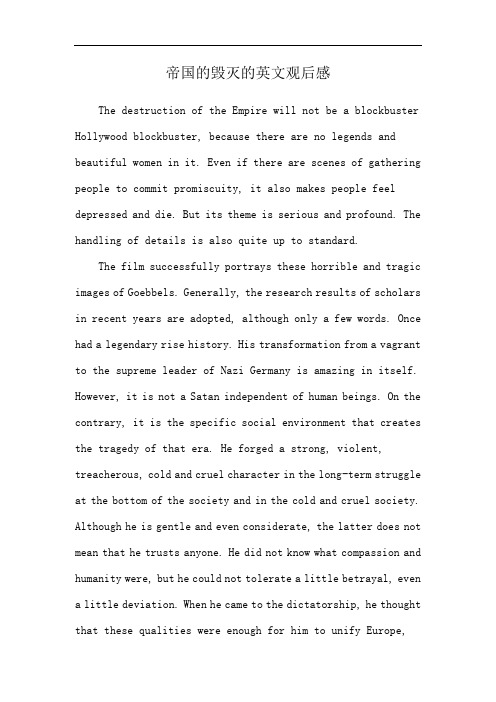
帝国的毁灭的英文观后感The destruction of the Empire will not be a blockbuster Hollywood blockbuster, because there are no legends and beautiful women in it. Even if there are scenes of gathering people to commit promiscuity, it also makes people feel depressed and die. But its theme is serious and profound. The handling of details is also quite up to standard.The film successfully portrays these horrible and tragic images of Goebbels. Generally, the research results of scholars in recent years are adopted, although only a few words. Once had a legendary rise history. His transformation from a vagrant to the supreme leader of Nazi Germany is amazing in itself. However, it is not a Satan independent of human beings. On the contrary, it is the specific social environment that creates the tragedy of that era. He forged a strong, violent, treacherous, cold and cruel character in the long-term struggle at the bottom of the society and in the cold and cruel society. Although he is gentle and even considerate, the latter does not mean that he trusts anyone. He did not know what compassion and humanity were, but he could not tolerate a little betrayal, even a little deviation. When he came to the dictatorship, he thought that these qualities were enough for him to unify Europe,eliminate red bandits, and establish a world ruled by Aryans. When he entered the underground bunker, these fanatical fantasies quickly turned into nonsense, which was no different from a madman. I think that while the director is trying to portray fanaticism, he also feels pity and even sympathy for his sad and lonely end.Philosophically, since the industrial revolution, scientism, pragmatism, positivism and Darwinism have been constantly mixed between science and humanity. On the one hand, traditional ethics has been constantly denied, such as the concepts of goodness and virtue, which have certain progressiveness. On the other hand, the law of the jungle and practical power have gradually become the mainstream concepts recognized by society. The development of history is so self contradictory, but this is how it happened.。
thelegendof1900观后感英文

thelegendof1900观后感英文"The Legend of 1900" is a captivating film that tells the story of a pianist who was born and raised on a cruise ship. The film, directed by Giuseppe Tornatore, takes viewers on a musical journey through the life of the protagonist known as 1900. As I watched this film, I was struck by the beautiful cinematography, the mesmerizing soundtrack, and the compelling story of a man who never leaves the ship where he was born.The film opens with a janitor named Max discovering a baby abandoned on a ship in the year 1900. He takes the baby in and raises him as his own, naming him Danny Boodman T.D. Lemon 1900. As 1900 grows up, he shows an extraordinary talent for playing the piano and becomes the ship's resident pianist. His music captivates passengers and crew alike, earning him the nickname "The Legend of 1900."One of the most striking aspects of the film is the performance of Tim Roth as 1900. Roth brings depth and emotion to the character, portraying 1900 as a gifted but lonely man who is torn between his love for music and his fear of the outside world. His piano playing is mesmerizing, and the soundtrack of the film, composed by Ennio Morricone, only adds to the beauty of his performance.The themes of love, loss, and the passage of time are woven throughout the film, as 1900 grapples with his place in the world and his relationships with those around him. His friendship with Max, played by Pruitt Taylor Vince, is particularly poignant, as Max serves as a father figure and mentor to 1900, guiding him through his musical career and personal struggles.As the film reaches its climax, 1900 is faced with a choice that will determine the course of his life. The tension builds as he confronts his fear of leaving the safety of the ship and venturing into the unknown. In a gripping and emotional finale, 1900 must decide whether to stay on the ship and continue his musical journey or step off into the world beyond.In conclusion, "The Legend of 1900" is a moving and thought-provoking film that explores the power of music, the beauty of friendship, and the courage to face the unknown. The performances, direction, and music combine to create a truly unforgettable cinematic experience. I highly recommend this film to anyone who appreciates a well-crafted story and a mesmerizing soundtrack. It is a film that lingers in the mind long after the credits roll, leaving a lasting impression on the heart.。
电影末代皇帝英文作文
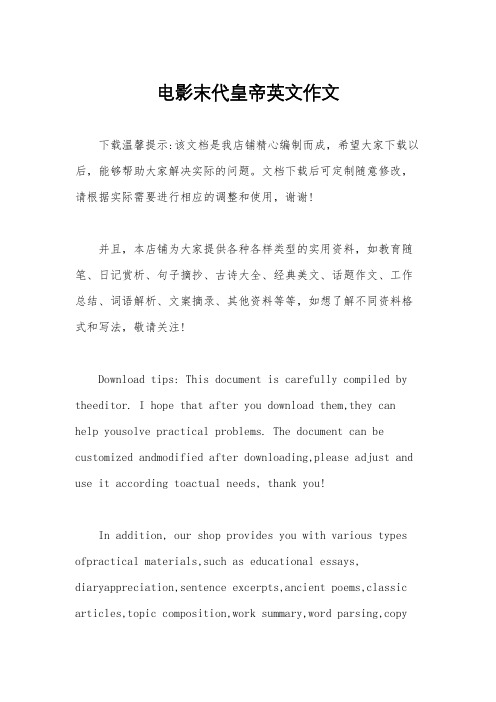
电影末代皇帝英文作文下载温馨提示:该文档是我店铺精心编制而成,希望大家下载以后,能够帮助大家解决实际的问题。
文档下载后可定制随意修改,请根据实际需要进行相应的调整和使用,谢谢!并且,本店铺为大家提供各种各样类型的实用资料,如教育随笔、日记赏析、句子摘抄、古诗大全、经典美文、话题作文、工作总结、词语解析、文案摘录、其他资料等等,如想了解不同资料格式和写法,敬请关注!Download tips: This document is carefully compiled by theeditor. I hope that after you download them,they can help yousolve practical problems. The document can be customized andmodified after downloading,please adjust and use it according toactual needs, thank you!In addition, our shop provides you with various types ofpractical materials,such as educational essays, diaryappreciation,sentence excerpts,ancient poems,classic articles,topic composition,work summary,word parsing,copyexcerpts,other materials and so on,want to know different data formats andwriting methods,please pay attention!The Last Emperor is a movie that tells the story of the life of Puyi, the last Emperor of China. It is a visually stunning film that takes the viewer on a journey through the tumultuous times of the early 20th century in China.The film begins with Puyi as a child, living in the Forbidden City and being groomed to be the next Emperor of China. As he grows older, he is faced with the reality that his world is changing rapidly, and that he may not be able to hold onto his position as Emperor for much longer.One of the most striking aspects of the film is its use of color and imagery. The scenes set in the Forbidden City are filled with bright, vibrant colors, while the scenes set in the outside world are more muted and subdued. This contrast helps to emphasize the isolation and confinement that Puyi feels as he is forced to leave his old life behind.As the film progresses, we see Puyi struggle to come to terms with his new reality. He is forced to abdicate his throne, and is later imprisoned by the Japanese during World War II. Through it all, we see him struggle with his own identity and his place in the world.One of the most moving scenes in the film is when Puyi is finally released from prison and returns to China. He is greeted by a world that has changed beyond recognition, and he struggles to find his place in it. Through it all, he remains a symbol of a bygone era, a reminder of a time when China was ruled by Emperors.Overall, The Last Emperor is a powerful and thought-provoking film that explores themes of identity, change, and the passage of time. Its stunning visuals and captivating story make it a must-see for anyone interested in Chinese history or world cinema.。
末代皇帝观后感英文200
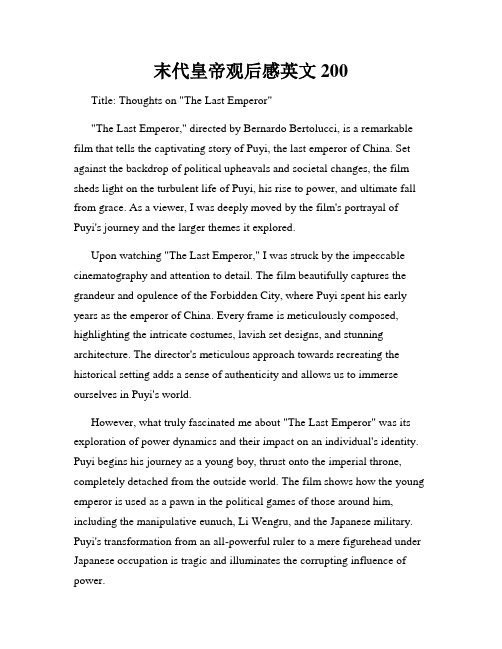
末代皇帝观后感英文200Title: Thoughts on "The Last Emperor""The Last Emperor," directed by Bernardo Bertolucci, is a remarkable film that tells the captivating story of Puyi, the last emperor of China. Set against the backdrop of political upheavals and societal changes, the film sheds light on the turbulent life of Puyi, his rise to power, and ultimate fall from grace. As a viewer, I was deeply moved by the film's portrayal of Puyi's journey and the larger themes it explored.Upon watching "The Last Emperor," I was struck by the impeccable cinematography and attention to detail. The film beautifully captures the grandeur and opulence of the Forbidden City, where Puyi spent his early years as the emperor of China. Every frame is meticulously composed, highlighting the intricate costumes, lavish set designs, and stunning architecture. The director's meticulous approach towards recreating the historical setting adds a sense of authenticity and allows us to immerse ourselves in Puyi's world.However, what truly fascinated me about "The Last Emperor" was its exploration of power dynamics and their impact on an individual's identity. Puyi begins his journey as a young boy, thrust onto the imperial throne, completely detached from the outside world. The film shows how the young emperor is used as a pawn in the political games of those around him, including the manipulative eunuch, Li Wengru, and the Japanese military. Puyi's transformation from an all-powerful ruler to a mere figurehead under Japanese occupation is tragic and illuminates the corrupting influence of power.As the film progresses, we witness Puyi's gradual awakening to the realities of the world outside the Forbidden City. Through his encounters with Western influences and his interactions with his tutor, Reginald Johnston, Puyi gains a newfound understanding of democracy and individual freedom. This transformation is particularly evident during his time in the Japanese-controlled puppet state of Manchukuo, where Puyi struggles to balance his allegiance to his country and his personal desires for liberation.The performances in "The Last Emperor" are exceptional, bringing depth and authenticity to the characters. John Lone delivers a remarkable portrayal of Puyi, capturing the emperor's vulnerability, inner conflicts, and eventual acceptance of his diminished role. His nuanced performance allows us to empathize with Puyi's struggles and reflect upon the complexities of power and identity.One crucial aspect of the film is its depiction of Puyi's relationships with women. From his infatuation with the beautiful Wanrong to the tragic love affair with his concubine, Wenxiu, these relationships serve as a poignant reminder of the personal sacrifices Puyi made for his position. The forbidden love between Puyi and Wenxiu is particularly heartbreaking, as it emphasizes the limitations imposed on the emperor by tradition and societal expectations."The Last Emperor" is not just a biographical film but also a profound commentary on the role of power and the inevitability of change. Puyi's fall from grace serves as a metaphor for the collapse of the imperial system in China, as the country transitions into a new era. The film prompts us tocontemplate the complexities of leadership and the human cost of political upheaval.In conclusion, "The Last Emperor" is a cinematic masterpiece that skillfully combines historical drama with themes of power, identity, and personal growth. Through its stunning visuals, superb performances, and thought-provoking narrative, the film provides an intimate look into the life of the last emperor of China and the tumultuous times in which he lived. This is undoubtedly a film that will leave a lasting impression on any viewer, regardless of their familiarity with Chinese history.。
末代皇帝英文作文
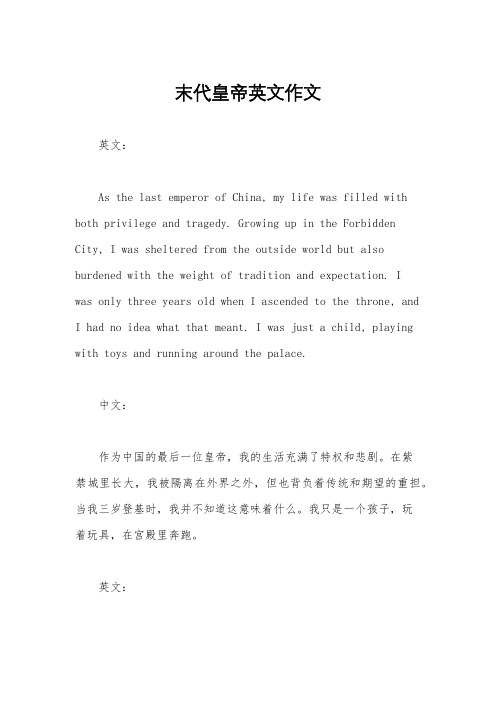
末代皇帝英文作文英文:As the last emperor of China, my life was filled with both privilege and tragedy. Growing up in the Forbidden City, I was sheltered from the outside world but also burdened with the weight of tradition and expectation. Iwas only three years old when I ascended to the throne, and I had no idea what that meant. I was just a child, playing with toys and running around the palace.中文:作为中国的最后一位皇帝,我的生活充满了特权和悲剧。
在紫禁城里长大,我被隔离在外界之外,但也背负着传统和期望的重担。
当我三岁登基时,我并不知道这意味着什么。
我只是一个孩子,玩着玩具,在宫殿里奔跑。
英文:As I grew older, I began to realize the gravity of my position. I was expected to be a symbol of Chinese powerand tradition, but I had no real power or agency. I wasjust a figurehead, controlled by the eunuchs and other officials who surrounded me. I was also isolated from the outside world, with no real understanding of the political and social changes that were happening in China and therest of the world.中文:随着我渐渐长大,我开始意识到我的职位的重要性。
2021年《末代皇帝》观后感3篇

A good retreat should be rewarded like a great victory.整合汇编简单易用(页眉可删)2021年《末代皇帝》观后感3篇《末代皇帝》观后感1《末代皇帝》是于1988年拍摄的电影,我看这部电影是在20__年,但我觉得这部电影的画质、质量不亚于当今的任何一部大作,我在想,中国八十年代就能拍出这么优秀的电影着实不易,可当我看到从编剧到导演都是英文字母组成的名字时,我陷入了沉思。
看完这部电影我是悲哀的,我的悲哀不是表现在我对溥仪的怜悯,而是我对中国电影的怜悯。
我悲哀的原因不是因为这部电影多么糟糕,而是因为它拍的实在是太好了。
一部人物传记类的电影,肯定要了解这个人的一生,要想了解这个人的一生就要了解当时的时代背景,按理来说中国的历史剧土生土长的中国人应该拍的很好,但却让老外占尽了风头,这就好比中国人去英国编排戏剧《莎士比亚》赢得了巨大成功一样,这对于英国人来说肯定是耻辱的,同样,外国人编排的《末代皇帝》取得成功同样也需要每个中国人的深思。
在看近几年中国人拍摄的历史剧,每部剧商业价值气息浓厚,完全违背了真正的历史,更可悲的是,越是歪曲历史,越是滑稽慌谬的历史剧越受中国观众的喜爱,大家看电影完全没有带着学习的思想,而只带着娱乐的心情。
这无异于对民族文化的侮辱和民族历史的践踏。
我只能期盼中国有一天能真正拍出属于自己的,扬名海外的历史题材电影,以张扬我中华民族博大精深的文化和源远流长的历史。
《末代皇帝》观后感2我想说,看完这部电影后,最大的感觉就是恍如隔世,我仿佛就像溥仪那样经历了60余载的人生,从清末登基,到伪满登基,再到建国后的思想改造,60年仿佛白驹过隙,回顾起来历历在目,然而,都像是一场梦。
终其前半生,溥仪都在皇权笼罩下不得逃脱。
小时候被困在紫禁城,长大后被困在新京长春,皇帝这个名号就像是一条麻绳,把他捆绑得紧紧的。
我又想起溥仪小时候,周围的太监都是这么教育他的:你是皇帝,你想要什么就有什么。
末代皇帝英语观后感200

末代皇帝英语观后感200《末代皇帝》英语观后感(200)《末代皇帝》是一部由贝纳尔多·贝托鲁奇执导,1987年上映的电影,该片是根据真实故事改编的。
它讲述了中国最后一个皇帝溥仪的生活经历, 演员令人印象深刻,影片的细节令人难以忘怀。
首先,电影以非线性的方式讲述了溥仪从幼年到成年的故事。
通过这种叙事方式,观众可以更好地理解他作为末代皇帝所面临的压力和挑战。
影片的导演通过闪回和剪辑,将溥仪在禁城的童年和成年生活与他在监狱中的生活相对比,突出了他的命运坎坷和改变。
在电影中,我特别被影片精湛的摄影和布景所吸引。
禁城的壮丽和特殊氛围通过华丽的服装和精心设计的景观得以体现。
在影片中,每一幕都充满了中国皇室文化的精华,它们为观众展示了一个精心构建的、充满谜团的世界。
溥仪的表演也是《末代皇帝》的一大亮点。
张国荣饰演的溥仪通过精彩的表演将其内心世界逼真地呈现在观众面前。
他的演技让我对溥仪这个历史人物产生了强烈的共鸣和同情。
他迷茫的眼神和无助的表情使我感受到了这位末代皇帝内心的挣扎和痛苦。
与此相对比是溥仪成年后被囚禁在监狱里的生活。
在影片的后半部分,我们看到了溥仪年老后的艰难岁月。
他从神圣至高的位置被推到人生最低谷,独自一人面对自己的罪过和孤独。
这种对比让我更深刻地反思了权力和命运的无常,以及作为领导者所承受的重压和责任。
此外,《末代皇帝》通过展示溥仪与不同人物之间的复杂关系,呈现出了中国历史上独特的社会结构。
从他与母后的关系到与宫廷内外的其他人的相处,影片揭示了权力斗争和宫廷阴谋的黑暗面。
这些情节使得影片更加引人入胜,也带给观众更多的思考。
在整部电影中最令我难以忘怀的是溥仪的转变和成长。
作为一个懵懂无知的孩子,他在成为皇帝后面临了巨大的困境和挑战,经历了人生的许多起伏。
他的自我反省和内心的挣扎让我深深感受到了作为一个领导者所需面临的压力和责任。
总的来说,《末代皇帝》是一部触动人心的电影,通过讲述溥仪的故事,它提供了深思熟虑的历史反思。
- 1、下载文档前请自行甄别文档内容的完整性,平台不提供额外的编辑、内容补充、找答案等附加服务。
- 2、"仅部分预览"的文档,不可在线预览部分如存在完整性等问题,可反馈申请退款(可完整预览的文档不适用该条件!)。
- 3、如文档侵犯您的权益,请联系客服反馈,我们会尽快为您处理(人工客服工作时间:9:00-18:30)。
"The Last Emperor" from the Perspective of Post-colonial Theory
Abstract: The movie "The Last Emperor" is a classic film that Italian director Bertolitch started shooting in China in 1984 and took three years to complete. After its release, it caused a huge sensation and won 9 Oscars. In the same year that the film was released, China began broadcasting the TV series "The Last Emperor" of the same name produced by its own artists. The drama aroused heated discussions in the literary and artistic circles, and in the same year won the "Flying Award", the highest achievement award in Chinese TV dramas.The study of two films of the same name from the perspective of Said’s post-colonial theory is to analyze the deep purpose behind the surface narration of the two films of the same name from the perspective of cultural politics:That is to say, on the one hand, according to the post-colonial logic of "Oriental image-imperialism-cultural resistance", analyze the "imperialist narrative logic" shown in the both film and television works.On the other hand, it analyzes the differences between eastern and western cultures by comparing both film and television works of the same name.
The content is divided into three parts. The first part is the introduction. Based on the two directors' different views on their own works, it pointed out the feasibility of conducting a comparative study between the both film and television works. The significance of the research is pointed out by summarizing the existing research literature. The second part is the body part, which is divided into three chapters. In the first chapter, through the analysis of the novel and negative Chinese images in “The Last Emperor”, it pointed out that the director fabricated the Chinese images with novel and prejudiced eyes. In the body part, the second chapter is on the basis of the first chapter, which pointed out that the fiction of the eastern image is in order to lay the foundation to establish the gain of imperialism and colonial interests , and through the comparison of the relationship development between the British Johnston, the Japanese Mr Amakasu and Pu Yi in the film to show the different ways of establishing two imperialist rule and the different means of obtaining benefits; Chapter three analyzes the differences between eastern and western cultures and the cultural resistance of TV drama to the film against imperialist narratives through different
writings of the same event in the movie "The Last Emperor". The third part is the conclusion. After summarizing the whole text, it pointed out that not only the film “the Last Emperor” shows the "Orientalism" which lacks understanding of Chinese culture, the TV series "The Last Emperor" also shows accusing the west of "Westernism". Although both film and TV drama failed to understand each other's cultural system, they showed their own nations’ unique cultural background in the process of telling stories. The film “The Last Emperor” reflects the western culture's tradition of paying attention to individuals, taking history as the background and telling the life course of "individuals". "The Last Emperor," on the other hand, reflected China's tradition of focusing on society and history, using "the individual" as a backdrop to reflect the direction of history in an attempt to reach a political height.。
